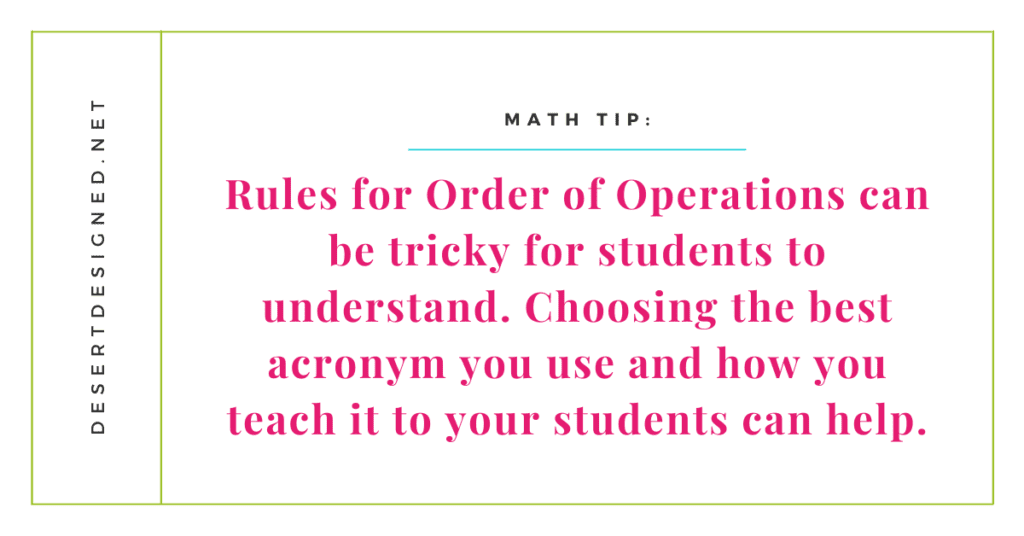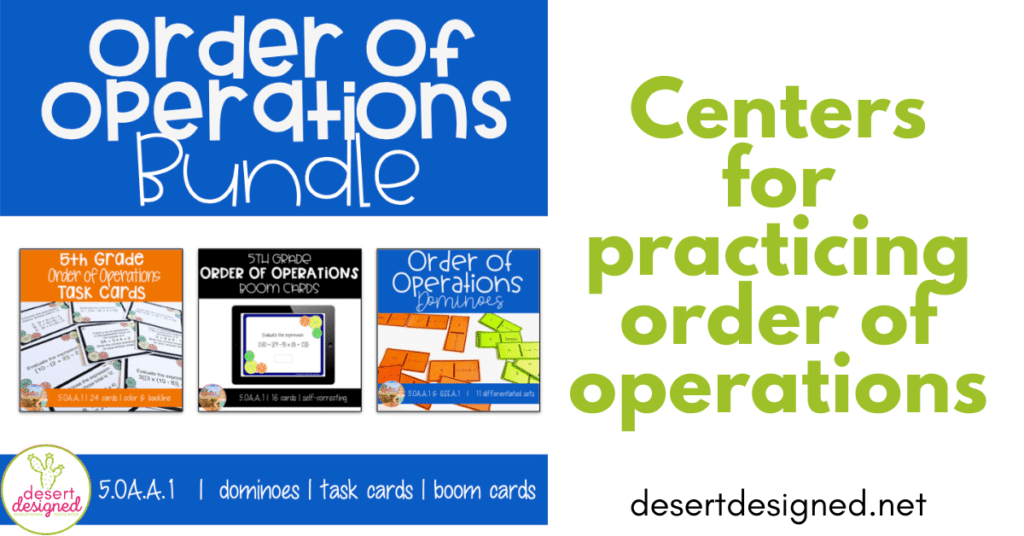
Rules for Order of Operations can be tricky for students to understand. The acronym you use and how you teach it to your students can help. Learn how my thinking has changed over time about teaching the rules for the order of operations.
Are you looking for new ways to make your math lessons more engaging? Join our mailing list and get a free, comprehensive guide with tips and activities for writing engaging math lessons today!

The Rules for the Order of Operations Aren’t As Simple as they Seem.
To adults familiar with the order of operations, the rules behind them may seem simple, but students who are just learning to follow the rules often struggle with their execution. Let’s dive into two commonly used acronyms used in classrooms to help students understand and remember the order in which to solve math expressions.

PEMDAS
I learned that this acronym meant “please excuse my dear aunt Sally” when I grew up. Here is the breakdown for the mathematical terms associated with each letter:
P – parentheses
E – Exponents
M – Multiplication
D – Division
A – Addition
S – Subtraction
PEMDAS is supposed to help us remember the order to solve the parts of a complex math equation.
Here is the problem, When we have students memorize PEMDAS, there are several confusing points.
We include parentheses, but what of brackets and braces, the other common grouping symbols. I supposed one could argue that they are a form of parentheses, so this doesn’t seem too egregious.
The next point of contention with PEMDAS is the separation of multiplication from division and addition from subtraction. It is essential that if you teach using this acronym, students must realize that multiplication, division is not an order in which to do these two operations, but that we must solve them from left to right. The same rule goes for addition and subtraction.
If you can help students remember those points, you will be in pretty good shape.
GEMS
The GEMS rules for order of operations are very similar to PEMDAS, with some minor changes.
G – Grouping Symbols
E – Exponents
M – Multiplication & Division
S – Subtraction & Addition
GEMS addresses several of the problems with the PEMDAS acronym. As you can see, parentheses are now “grouping symbols.” Additionally, rather than separating multiplication from division and addition from subtraction, GEMS groups these like-operations into single categories. This is great in terms of meaning but does require students to remember that they go together.
Why Students Get Confused
So, you may be thinking these rules for order of operations, whether GEMS or PEMDAS, seem pretty basic and easy to understand. Why are kids still getting confused? After years of watching kids work on these problems, this confusion has become pretty clear to me. Several things confuse kids.
First, we expect students to understand that these rules imply a specific order to perform the operations. Students sometimes do not realize that the step-by-step order is in place. It is challenging to explain when using PEMDAS as an acronym since the MD and AS are listed separately but are supposed to be done on the same level.
After diving in, I have found six typical order of operations mistakes that students make. You can check out this blog post to see what they are and how I help my students overcome them.
When Students Understand the Rules for Order of Operations
Students who fully understand the rules that accompany the order of operations problems can quickly solve these problems. I have found that kids find the order of operations problems fun because the rules are straightforward once mastered!
How We Can Make the Rules for Order of Operations More Clear

What do we do as teachers to help students achieve this level of mastery? I break this down for you here:
Scaffold the Steps
When you first introduce the order of operations, assume your students have never heard of this process before. Even if you are sure it was taught to them in prior years, start at the most basic level. If you notice that students are picking up on the concept quickly, that’s great! It’s easier to speed up the level of instruction rather than backpedal and undo the confusion that accompanies skipping essential steps.
To break it down, I start with one operation and slowly fold in others. The initial problems will start with three terms. For example, we will do 5 + 6 + 2. I show students how to write the solution to 5 + 6 below that part of the problem. Next, we bring down the + 2 next to it. Sure, I get a few eye rolls from the kids who can do this in their heads, but they are now used to me introducing complex concepts with easy-to-use numbers.

Once kids see the solution process for these problems, I slowly expand the problems to include more operations and terms.
Parentheses First, then Other Grouping Symbols
The G in Gems stands for grouping symbols. After students have mastered solving problems with three to five terms, I introduce grouping symbols. The parentheses are usually not a problem, but I do make sure to throw some parentheses with three terms inside as we practice this to help them realize that they still need to follow the order of operations when working within parentheses.
After we master parentheses, I introduce the other grouping symbols, brackets, and braces. I help students understand that when working on grouping symbols, we work from the inside out. As I teach the rule for grouping symbols, I mention the “inside out” part of the rule even when we are only working on parentheses.
Teaching the Rules Explicitly
Another critical factor in helping my students understand the rules for order of operations is to focus on phrases or sentences, not individual words. For example, I don’t teach G as “grouping symbols.” I teach it as grouping symbols from the inside, out. I teach M as “multiplication and division, left to right.” Finally, S is “subtraction and addition, left to right.”
Teaching the acronym this way is more of a mouthful but helps students remember what they need to do in the long run.
Making a Gem
If you are using the GEMS acronym, you can tie the shape of the completed problem in layers to the shape of an actual gem. Using this process encourages students to work through the problem step-by-step, increasing their overall accuracy in their calculations.
GEMS vs PEMDAS
Since growing up using PEMDAS, GEMS threw me for a loop at first. I thought the colleague who introduced it to me was a little cuckoo. However, I’m never afraid to try something new and do a little A/B testing when it makes sense.
I’m a convert. I like using GEMS instead of PEMDAS now when I’m teaching the rules for order of operations to my students. I have found that they have better retention for what they are supposed to do and when.
One of the biggest challenges with teaching order of operations to students is having enough practice problems to meet their practice needs. I love using this Order of Operations Bundle with my class. Check it out today and see if it makes sense for you to use too!




